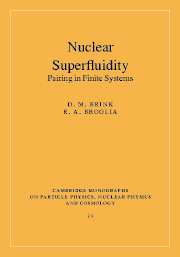Book contents
- Frontmatter
- Contents
- Preface
- 1 Introduction
- 2 The pairing force and seniority
- 3 The BCS theory
- 4 Spontaneous symmetry breaking
- 5 Pairing vibrations
- 6 Phase transitions
- 7 Plastic behaviour of nuclei and other finite systems
- 8 Sources of pairing in nuclei
- 9 Beyond mean field
- 10 Induced interaction
- 11 Pairing in exotic nuclei
- Appendix A A brief résumé of second quantization
- Appendix B Single particle in a non-local potential
- Appendix C Useful relations in the treatment of collective modes
- Appendix D Particle-vibration coupling
- Appendix E Model of the single-particle strength function
- Appendix F Simple model of Pauli principle corrections
- Appendix G Pairing mean-field solution
- Appendix H Pairing in a single j-shell
- Appendix I Fluctuations and symmetry restoration
- Appendix J RPA solution of the pairing Hamiltonian
- Appendix K Vortices in nuclei
- Appendix L Josephson effect
- References
- Index
Preface
Published online by Cambridge University Press: 17 August 2009
- Frontmatter
- Contents
- Preface
- 1 Introduction
- 2 The pairing force and seniority
- 3 The BCS theory
- 4 Spontaneous symmetry breaking
- 5 Pairing vibrations
- 6 Phase transitions
- 7 Plastic behaviour of nuclei and other finite systems
- 8 Sources of pairing in nuclei
- 9 Beyond mean field
- 10 Induced interaction
- 11 Pairing in exotic nuclei
- Appendix A A brief résumé of second quantization
- Appendix B Single particle in a non-local potential
- Appendix C Useful relations in the treatment of collective modes
- Appendix D Particle-vibration coupling
- Appendix E Model of the single-particle strength function
- Appendix F Simple model of Pauli principle corrections
- Appendix G Pairing mean-field solution
- Appendix H Pairing in a single j-shell
- Appendix I Fluctuations and symmetry restoration
- Appendix J RPA solution of the pairing Hamiltonian
- Appendix K Vortices in nuclei
- Appendix L Josephson effect
- References
- Index
Summary
The present monograph aims to provide an account of the basic results obtained in the exploration of the subject of nuclear superfluidity, placing special emphasis on recent developments coming out from ongoing research, in particular medium polarization and pairing in exotic nuclei.
The marked mass dependence of the abundance of nuclear species testifies to the fact that nucleons in nuclei move essentially independently of each other in an average potential produced by the effect of all the other nucleons. Special stability is ascribed to the closing of shells in correspondence with magic numbers. Adding nucleons to a closed shell system polarizes the shells, leading eventually to deformations. The best studied of these phase transitions are associated with deformations in: (a) three-dimensional space (violating angular momentum conservation, i.e. rotational invariance), (b) gauge space (violating particle number conservation, i.e. gauge invariance).
The phenomenon of spontaneous symmetry breaking in gauge space (i.e. the fact that the Hamiltonian describing a system is symmetric with respect to gauge transformations while the state is not) is intimately connected with nuclear superfluidity. This is the subject of Chapters 1, 2 and 3.
While potential energy always prefers special arrangements and thus leads to the spontaneous symmetry-breaking phenomena, fluctuations favour symmetry, leading to collective modes (intimately connected with symmetry restoration): pairing rotations and pairing vibrations, analogues in gauge space to rotations in three-dimensional space of the system as a whole, as well as to (multipole) surface vibrations respectively. This is the subject of Chapters 4, 5, and 6.
- Type
- Chapter
- Information
- Nuclear SuperfluidityPairing in Finite Systems, pp. xi - xivPublisher: Cambridge University PressPrint publication year: 2005



